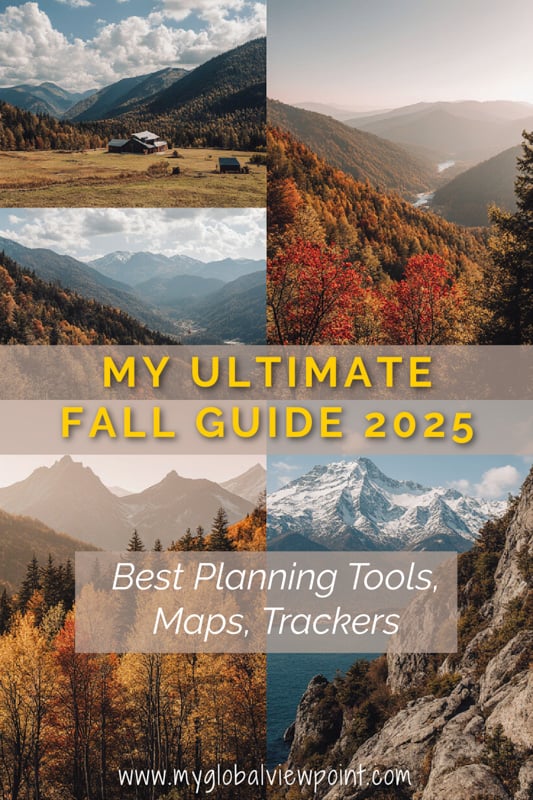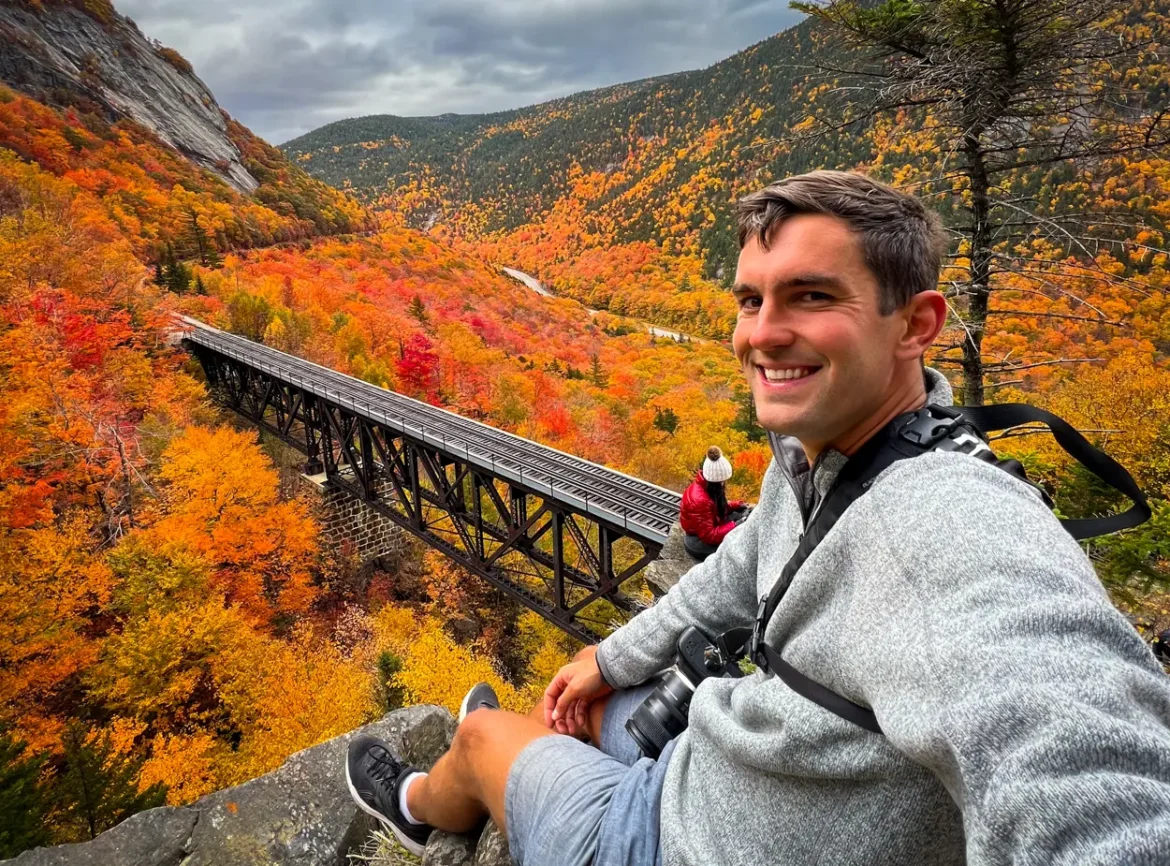I’ve been chasing fall colors for over 10 years, from Vermont’s winding Route 100 to the blazing aspens of California’s Sierra. Every season, the hardest part isn’t finding the best drives or hikes…it’s the planning. Figuring out when to go is tricky. Peak colors shift every year depending on elevation, weather, and even sudden storms. You can plan for October 10th one year and be a week late the next. For years, I pieced together scraps of info from state websites, news reports, and word of mouth…and it always felt like a guessing game. That’s why I built this guide.
My fall foliage planning guide pulls together the most accurate, up-to-date foliage maps and trackers across the United States, all in one place. Whether you’re heading to New England, the Smokies, or the Rockies, you’ll find the exact tools locals use to track peak color. Plus, I’ll share my recommendations on the best destinations, scenic drives, and webcams to check before you hit the road.
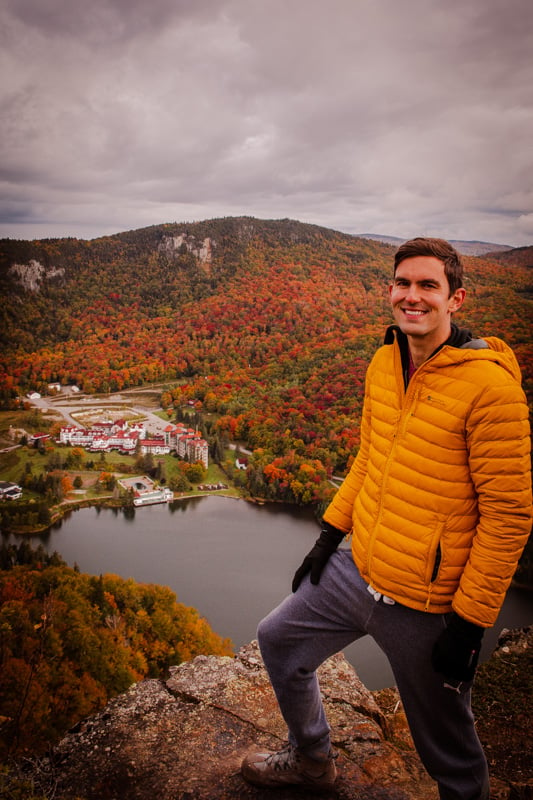
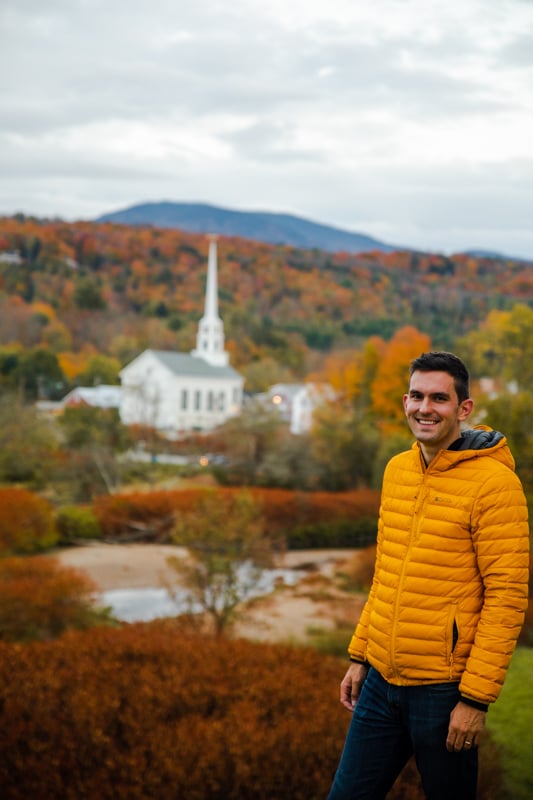
Table of Contents
Nationwide Fall Foliage Maps (for early planning)
When I’m sketching out trips months ahead, I always start by looking at a national map. These tools aren’t perfect, but they give me a baseline sense of when each region usually hits peak foliage. Once I’m within a few weeks of travel, I switch over to the state and local trackers later in this article…that’s where the real accuracy comes in.
- Explore Fall: National Map – Updated daily with forecast layers plus verified crowd reports across the U.S. I use it to see if a region is running early or late compared to average.
- SmokyMountains.com Fall Foliage Map – A national prediction model and an embeddable widget. Great for a big-picture view, but I always confirm with state forester reports before booking.
- Old Farmer’s Almanac Peak Map – Shows historical averages by region. Handy if I’m booking flights or hotels far in advance, but I treat it as a baseline, not a live forecast.
In the next section, I’ve put together my favorite autumn destinations, to give you an idea of what’s out there. I’ve also included all the local maps, trackers, and foliage predictions in each corresponding section below.
Best Fall Foliage Destinations at a Glance (2025)
Here are some of my go-to fall foliage destinations that I recommend using as a starting point. Keep reading below to see the fall foliage maps and trackers for live conditions by region.
| Destination | Typical Peak | Why Go |
|---|---|---|
| Stowe & Route 100, Vermont | Early to mid-October (higher peaks first) | Classic New England charm with winding Route 100, mountain views, and covered bridges |
| White Mountains, New Hampshire | Early October at higher elevations, mid to late October in valleys | Iconic Kancamagus Highway, Franconia Notch hikes, and Mount Washington vistas |
| Acadia National Park, Maine | Mid-October | Ocean cliffs, granite peaks, Jordan Pond trails, and coastal drives |
| Adirondacks, New York | Late September to mid-October (depending on elevation) | High Peaks wilderness, Lake Placid, and Whiteface Veterans’ Highway |
| Poconos, Pennsylvania | Mid to late October | Scenic Route 6, waterfalls, and fall hikes in Lehigh Gorge State Park |
| Shenandoah National Park, Virginia | Mid to late October (ridges first, valleys later) | 105-mile Skyline Drive, panoramic overlooks, and Appalachian Trail access |
| West Virginia Highlands | Late September to early October (highest elevations) | Dolly Sods, Canaan Valley, and Spruce Knob – some of the earliest color in the East |
| Blue Ridge Parkway, North Carolina | Early October (high elevations), late October (lower elevations) | Sweeping overlooks, Linn Cove Viaduct, and Craggy Gardens hikes |
| Great Smoky Mountains NP (TN/NC) | Late September (highest peaks) through early November (valleys) | Longest season in the East – Cades Cove, Newfound Gap, waterfalls |
| Door County, Wisconsin | Mid-October | Coastal drives, lakeside villages, and Peninsula State Park views |
| Upper Peninsula, Michigan | Late September (north) to mid-October (south) | Brockway Mountain Drive, Porcupine Mountains, and Pictured Rocks lakeshore |
| Minnesota North Shore | Late September to early October | Split Rock Lighthouse, Gooseberry Falls, and Lake Superior backdrops |
| Eastern Sierra, California (Mammoth, June Lake) | Late September to mid-October (by elevation) | Aspen-lined June Lake Loop, Rock Creek, and Conway Summit |
| Colorado San Juan Mountains | Late September to early October | Telluride, Ouray, and the Million Dollar Highway framed by golden aspens |
| New Mexico Enchanted Circle | Early to mid-October | Taos Ski Valley, Angel Fire, and aspens circling the Sangre de Cristos |
| Flagstaff, Arizona | Mid-October | Golden aspens in San Francisco Peaks, Lockett Meadow, and Snowbowl scenic drive |
| Columbia River Gorge, Oregon | Mid to late October | Dramatic waterfalls framed by vine maples and bigleaf maples |
For more inspiration on my favorite fall getaways, read my other guide: My Favorite Fall Foliage Destinations Across the USA
New England (CT, ME, MA, NH, RI, VT)
As a local, New England is where my love for fall foliage really took hold. The northeast is world famous for its fall colors, and each state offers detailed tracking to help you find peak color in the rolling hills and quaint villages. Typically, colors start in northern New England by mid/late September and move southward into October, but exact timing can vary with the weather. These are some of my favorite New England towns, farms, and festivals to see the fall colors in 2025.
Before you lock in dates, sanity‑check the region with Yankee Magazine’s Peak Foliage Map. It’s a preseason baseline that helps you choose early, middle, or late windows by subregion. Then rely on the state trackers below for live updates. Here are my go-to resources by state and region.
- Read my guide: My Favorite Fall Foliage Airbnbs in New England
Vermont
Vermont is where I go when I want that postcard-perfect mix of red maples and golden hillsides. My first stop is usually Route 100, which winds through the spine of the Green Mountains. Around late September, I’ll check the Northeast Kingdom, including Lake Willoughby, and higher elevations near Stowe, since they turn first. From there, I follow the color south into the Mad River Valley and Woodstock area in early October. There are tons of amazing fall foliage cabins and vacation homes in the area that I love spending long weekends.
What makes planning here tricky is how fast weather can change things…a cold snap can shift the window by days. That’s why I rely on the Vermont Foliage Report. It’s updated weekly with on-the-ground notes from foresters, so I can pivot: if the NEK is already past peak, I’ll drop into the valleys where colors are still coming on strong.
- Read also: My Favorite Apple Picking Spots in Vermont
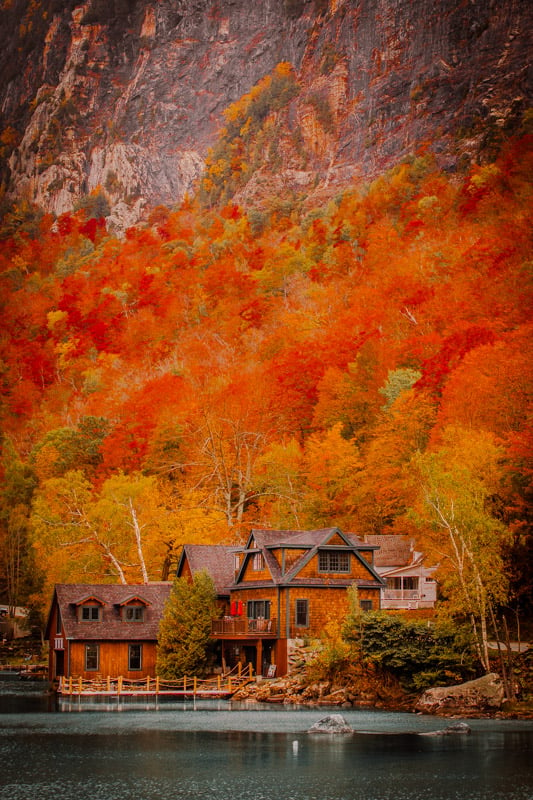
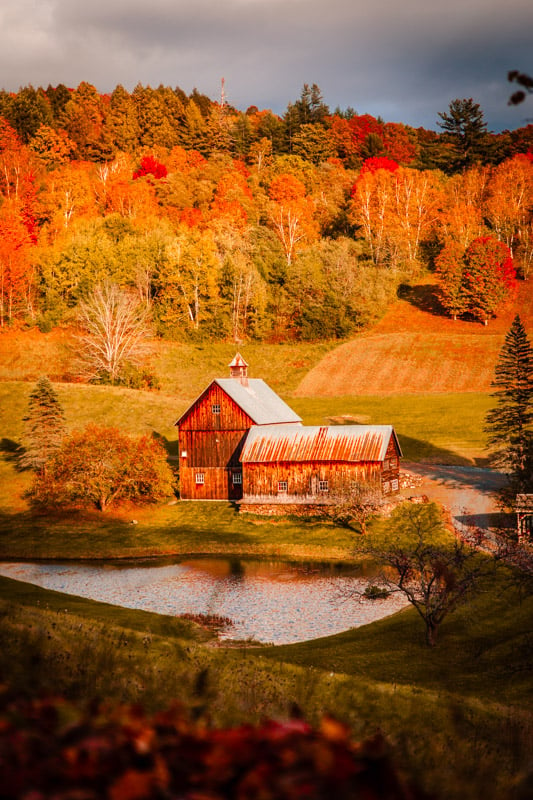
New Hampshire
For me, New Hampshire’s White Mountains are all about big, sweeping views. The Kancamagus Highway, Franconia Notch, and Mount Washington Valley usually peak around the first or second week of October, depending on elevation. If I miss it up high, I’ll head to the Lakes Region or Lake Winnipesaukee, which usually peak a week or two later.
The state’s VisitNH Foliage Tracker makes planning easier…it has a live map and weekly regional reports that let me see how each zone is progressing. I also use the NH Peak Foliage Map as a baseline for typical timing. My trick here is simple: start with the Great North Woods in late September, aim for the Whites in early October, then slide south toward the lakes and Monadnock region later in the month.
- Read next: My 7 Favorite Retreats in the White Mountains
- You may also like: The Coolest Places to Visit in NH
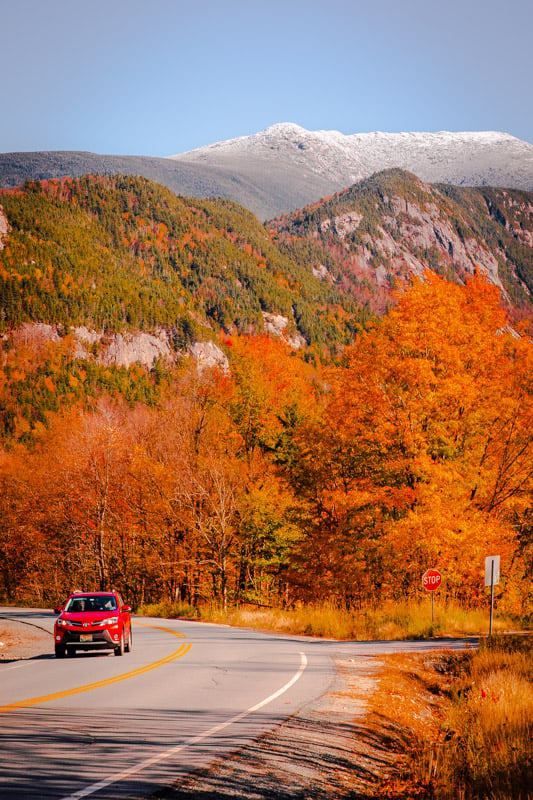
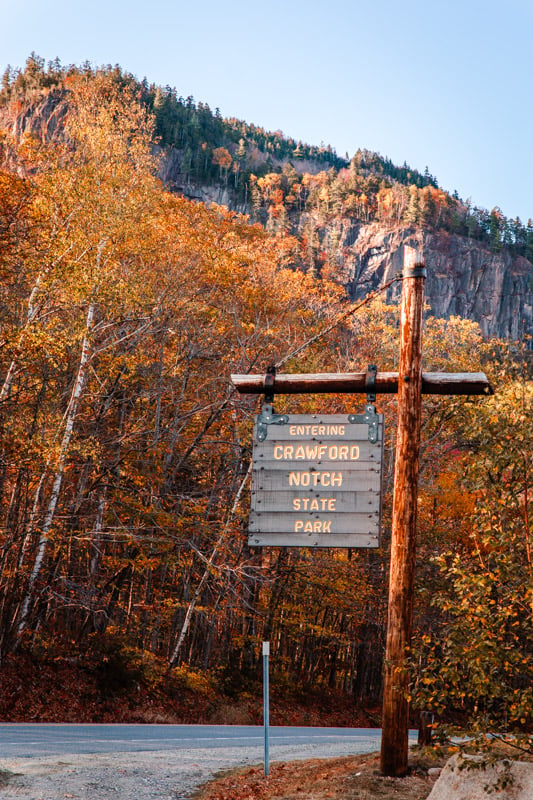
Maine
Maine’s season is long and rewarding if you plan it right. I usually start in Baxter State Park and the Rangeley Lakes region in late September, when the hardwoods up north peak early. By early to mid-October, I pivot east to Acadia National Park, where the combination of mountains and ocean cliffs makes for an incredible backdrop. By late October, the Mid-Coast towns and southern Maine forests still hang on, so there’s always a second chance if I miss the north.
The key here is the Maine Foliage Report. Forestry staff post weekly color percentages and leaf drop by zone, plus photos. I like looking back at their archived reports from past years…it shows me how long the coast tends to hold out.
- Read next: My Ultimate Boston to Maine Road Trip Guide
- You’ll also like: My Absolute Favorite Places to See in Maine
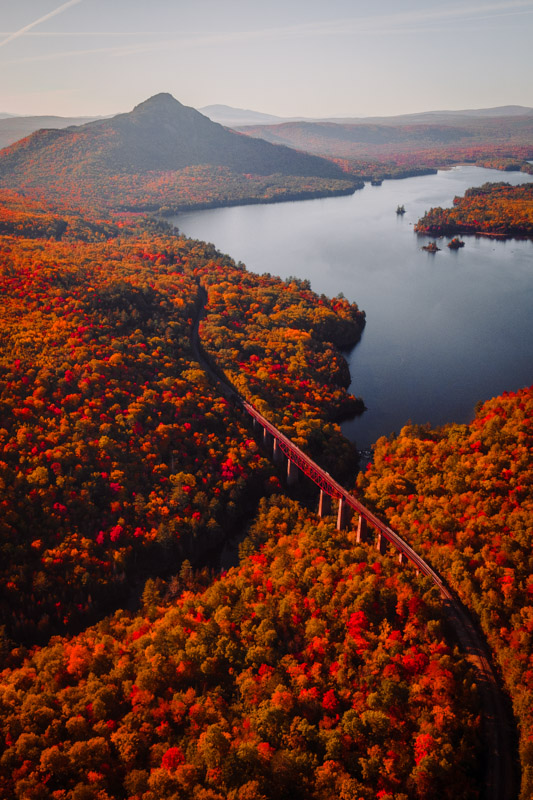
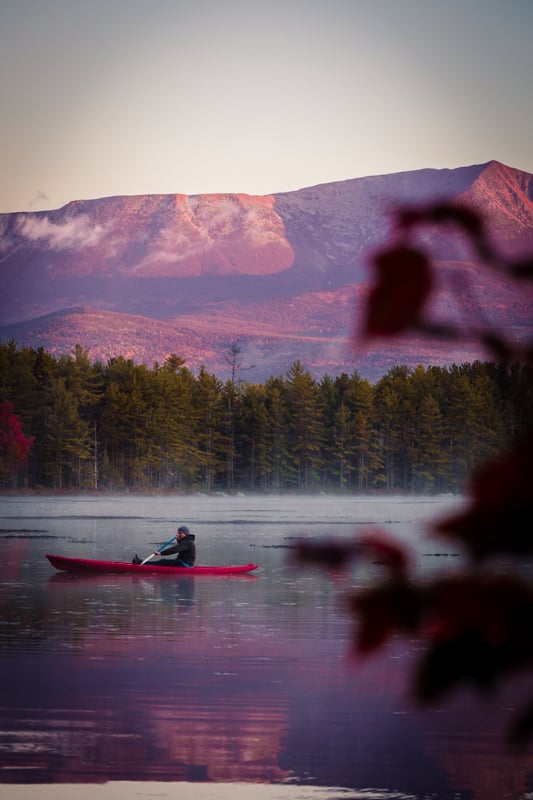
Massachusetts
Massachusetts has a built-in safety net because west to east timing is staggered. I usually start in the Berkshires around early October. Driving the Mohawk Trail or hiking Mount Greylock is tough to beat! A week or two later, I’ll check Central Massachusetts, and by late October, the North Shore, Boston, the South Shore, and Cape Cod still glow with late yellows and russets.
✈️ My #1 Tip for Cheap Flights:
If you’re not using Going, you’re probably overpaying for flights. I’ve scored roundtrips to Europe for under $300 - and I never would’ve found them on Google Flights.
Their free version is great, but Premium is where the real magic happens. I recommend doing the 14-day free trial. And right now, you can get 25% off Premium or Elite with my code: JON25.
Seriously, it’s the best travel decision I’ve ever made (in 8+ years).
The new Massachusetts DCR Fall Foliage Map is great for trip planning…it shows real-time conditions in state parks and along major routes. I also keep an eye on the Fall Foliage in the Parks page, which links the interactive layer. My strategy here: book a Berkshires weekend early, but leave room to pivot east if a storm strips the leaves too quickly.
- Read also: My Berkshires Fall Guide
- You’ll also like: My Favorite Fall Things to Do in Cape Cod
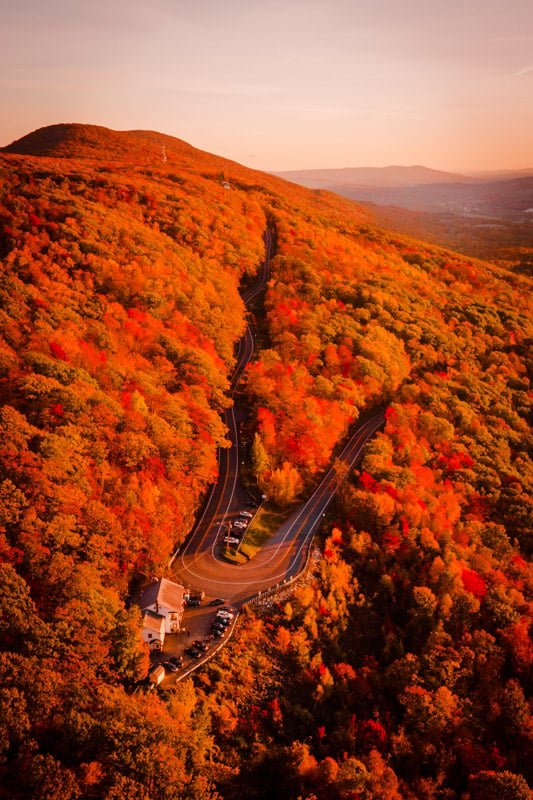
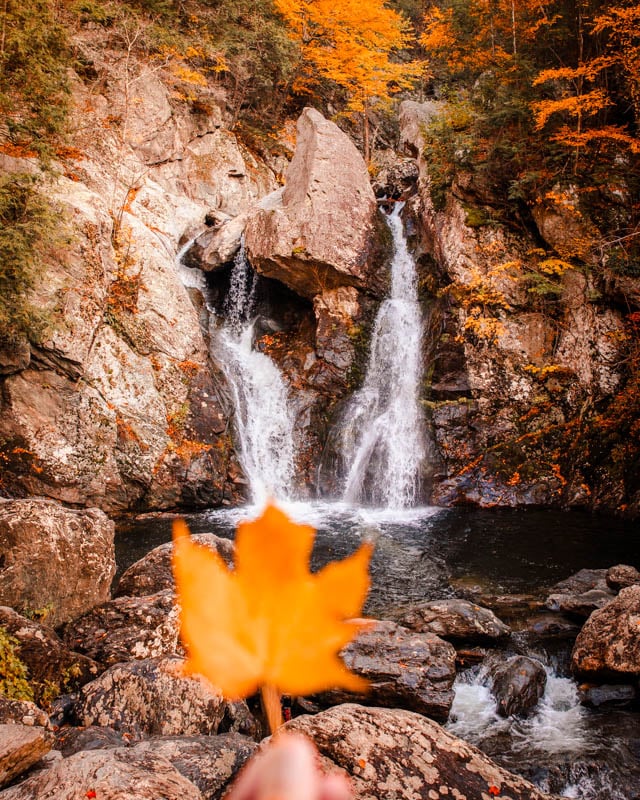
Connecticut
I love that Connecticut stretches the season longer than you’d expect. The Litchfield Hills and the Quiet Corner usually turn first, so I head there in early to mid-October. By late October, the Connecticut River Valley and shoreline still have strong color, which makes for beautiful coastal drives.
To time it right, I use the CT DEEP Fall Foliage Report, an ArcGIS story map updated weekly with percentages and photos. I like to use this along with the CTvisit Foliage Tracker, which lays out a week-by-week forecast and driving routes. If summer has been dry, I plan for the coast to turn earlier than usual, so I check these trackers closely before heading south.
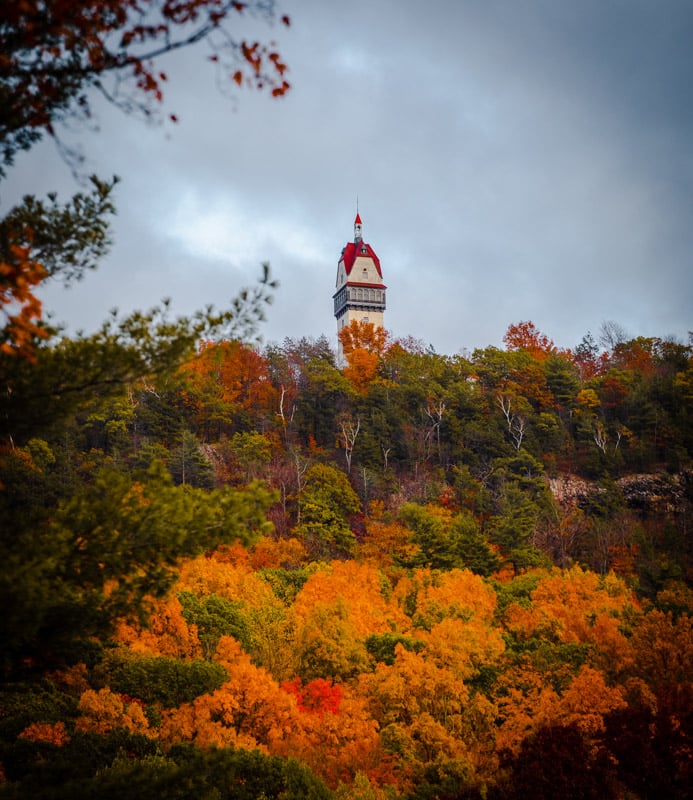
Rhode Island
Rhode Island is small enough that you can cover multiple regions in a single day. I like starting in the Blackstone Valley or Arcadia Management Area, then finishing with a drive along Narragansett Bay. Inland forests tend to peak by mid-October, while coastal areas like Newport and Providence hold color until late October or even early November.
The Visit Rhode Island foliage page is my go-to for timing. It doesn’t give daily reports, but it lays out typical windows and suggests scenic byways. Because the state’s window is short, I usually watch the Massachusetts and Connecticut trackers too…they help me anticipate when Rhode Island will be in its sweet spot.
- Read also: The Most Beautiful Spots to See in Rhode Island
- You’ll also like: My Top Recommended New England Fall Tours
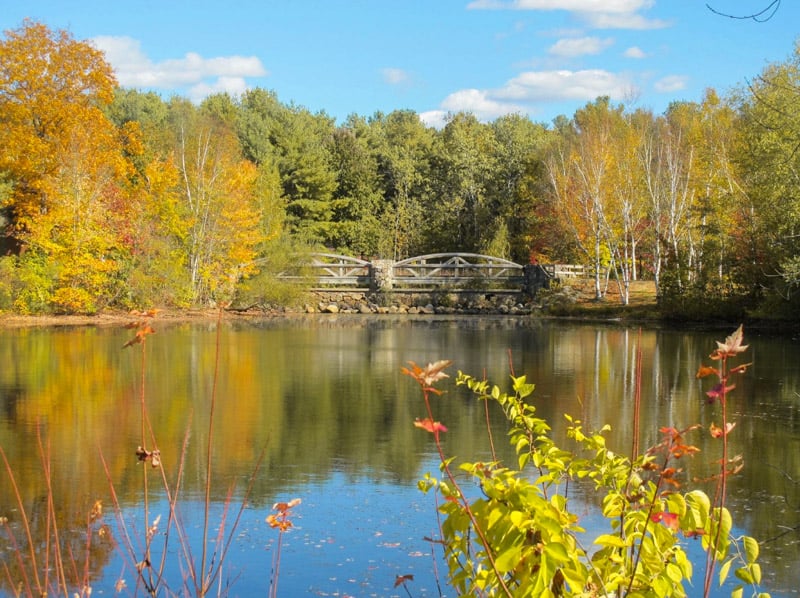
Mid‑Atlantic (MD, NY, PA, VA, WV)
When I plan fall foliage in the Mid-Atlantic, I don’t treat it as a straight north-to-south trip…the mountains throw a curveball. High elevations peak early: New York’s Adirondacks and West Virginia’s Allegheny Highlands often blaze by late September or early October. If I’m chasing that show, I head there first.
The alternative is to hold back and aim for a later run: mid-October through Pennsylvania’s ridges and valleys, then down into Maryland’s Catoctin and Virginia’s Blue Ridge and Shenandoah. Those lower valleys and Piedmont regions usually last into early November. The trick is choosing your strategy each year…go early to bag the mountain peaks, or wait a couple weeks and string together the rolling hills and valleys further south. Either way, you’ll catch a wave of peak color somewhere along this corridor.
New York
New York’s size means you can chase fall color for nearly six weeks if you plan it right. I usually start in the Adirondack High Peaks in late September or early October. Lake Placid, Whiteface Mountain, and Saranac Lake are incredible when the maples hit peak. By mid-October, I pivot to the Catskills, especially around Hunter Mountain and Kaaterskill Falls, where the mix of hardwoods and waterfalls is unbeatable. The Finger Lakes usually come into their own mid to late October…wine country plus rolling hills of color make it one of my favorite late-season stops. Finally, the Hudson Valley (Storm King, Mohonk Preserve) and even Long Island stretch the show into early November.
The I LOVE NY Fall Foliage Report is essential. It posts spotter updates from every region each week, with percentages, color brilliance notes, and travel ideas. I subscribe to their newsletter so I can plan my weekend road trips around where the color is peaking.
- Read also: My Upstate New York Bucket List
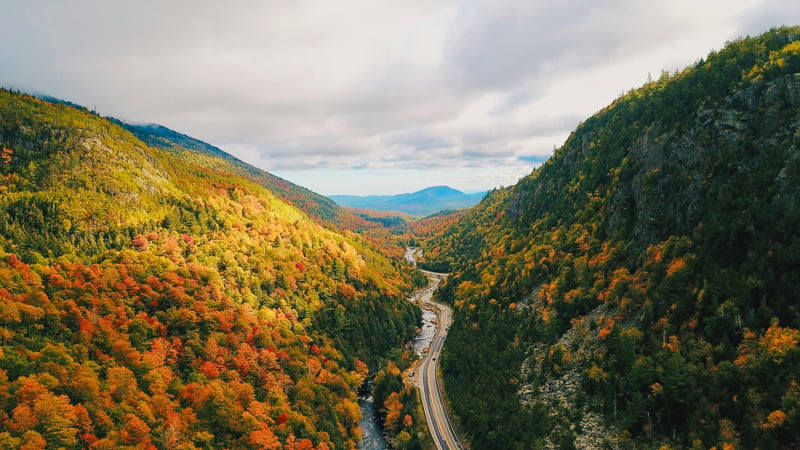
Pennsylvania
Pennsylvania is one of the most underrated fall destinations. The PA Wilds and Laurel Highlands offer endless ridge-and-valley overlooks, and the Poconos are famous for waterfalls framed by bright maples. I usually target northern PA first (Tioga State Forest, Loyalsock Canyon) in early October, then drop south into the Poconos and central ridges mid-October. By late October, the Laurel Highlands and even Gettysburg are often at peak.
The DCNR Fall Foliage Reports are gold. Each Thursday from late September to October, the Bureau of Forestry posts a detailed PDF with a statewide color map, regional breakdowns, and even route suggestions. Their accompanying StoryMap is interactive and helps me decide between chasing a ridge drive or exploring a state park.
- Read also: My Favorite Pennsylvania Hidden Gems
- You’ll also like: My Guide to Visiting Jim Thorpe
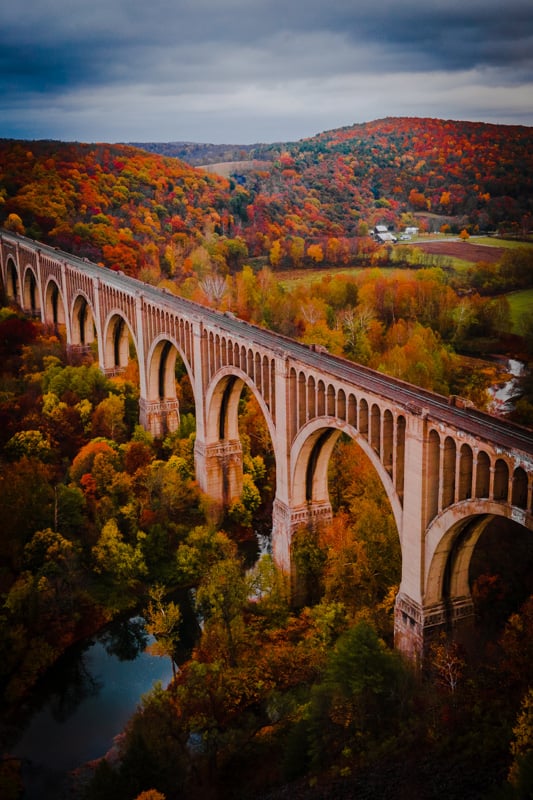
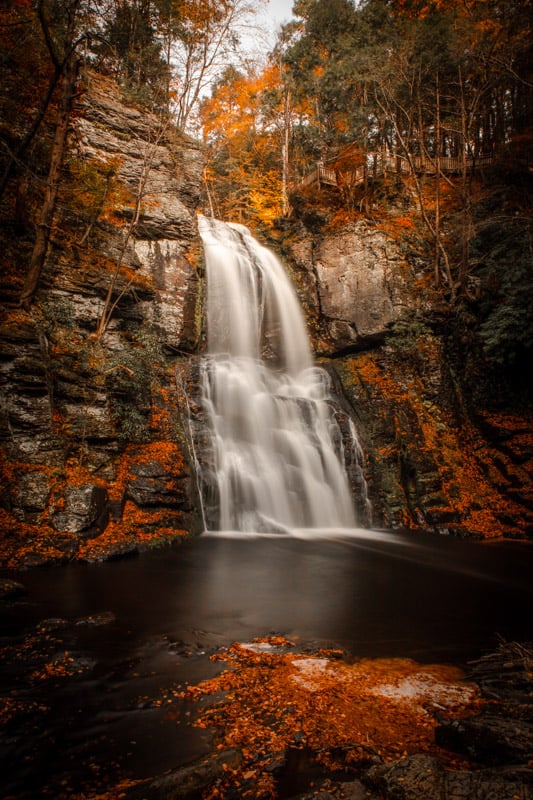
Maryland
Maryland packs a surprising amount of variety. Garrett County and Deep Creek Lake in western Maryland peak first, usually in early October, and are great for a mountain getaway. A week later, I’ll aim for Catoctin Mountain Park or the Appalachian Trail sections near Frederick. By late October, color spreads into central Maryland…Patapsco Valley and Gunpowder Falls are close to Baltimore and perfect for a quick hike. Early November still brings yellows to the Eastern Shore, especially around Blackwater National Wildlife Refuge.
The Maryland DNR Fall Foliage Report blog posts weekly updates with photos and forester notes from each region. It’s the fastest way to decide if I should head west for a big weekend trip or stay local near the Bay for lingering color.
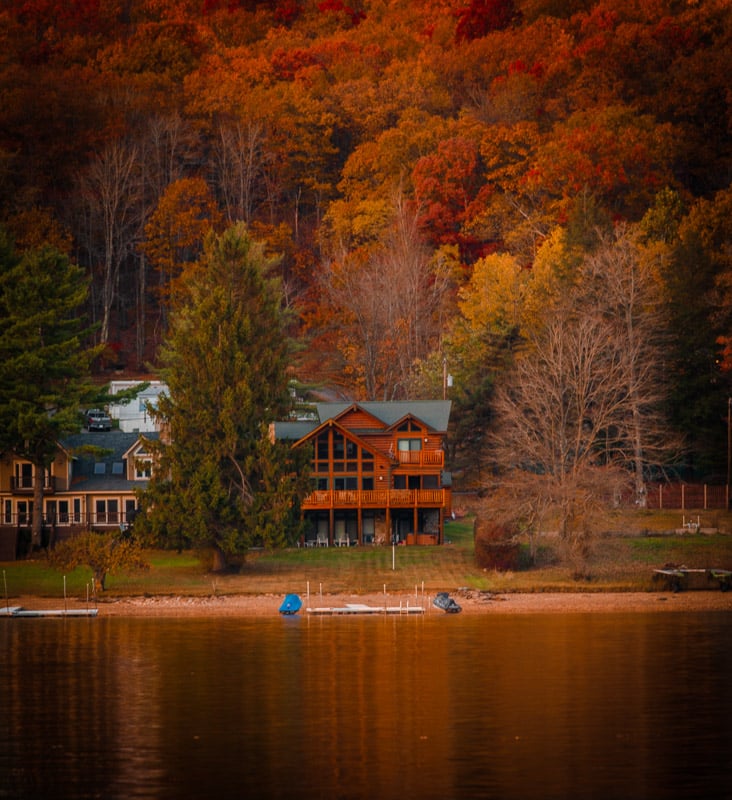
Virginia
Virginia’s long season is all about elevation. I usually start in Shenandoah National Park along Skyline Drive, where the upper ridges often peak mid-October. By late October, the color drops into the Blue Ridge Parkway, with vibrant views around Peaks of Otter and Mabry Mill. The Piedmont wine country around Charlottesville usually glows late October into early November, and the Tidewater and Eastern Shore can still show good color into mid-November.
For planning, I use the Virginia Department of Forestry Fall Foliage page…their weekly updates break down what’s changing where, with field reports from foresters. The Virginia Is For Lovers report aggregates those updates and adds trip ideas, like scenic byways and small towns. The combo helps me know not just what’s peaking, but where to go enjoy it.
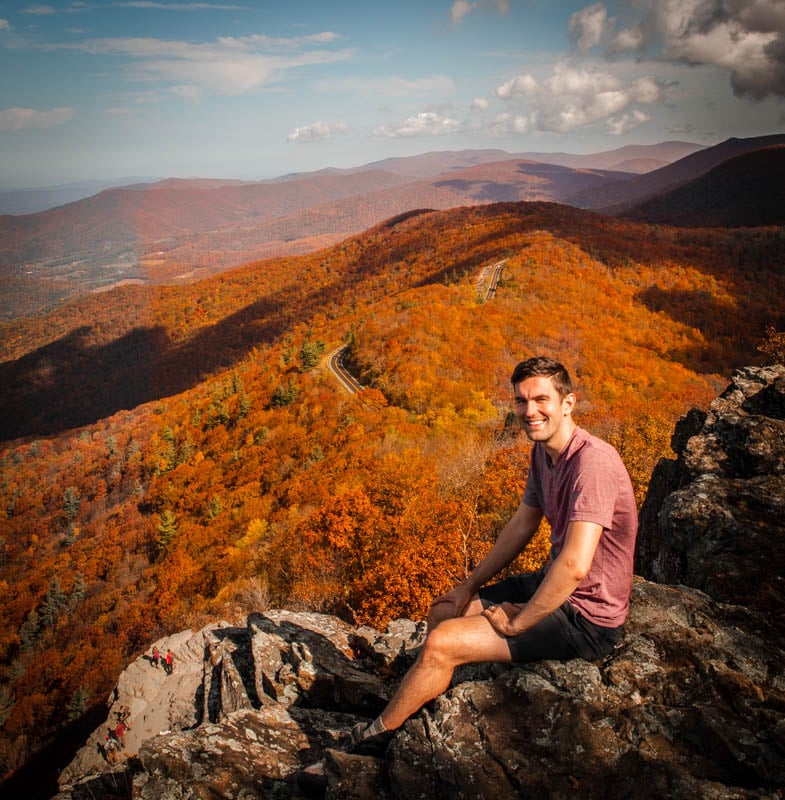
West Virginia
West Virginia often surprises people by how early its highlands turn. Places like Dolly Sods, Spruce Knob, and Canaan Valley can hit peak as early as late September or the first week of October. I like to plan a Highlands trip early, knowing I’ll still have the New River Gorge and lower valleys to catch later in October. The season here moves fast, with sweeping views that can change within days if a cold front blows through.
The West Virginia Live Leaf Map is my planning anchor. It starts with a projection map released in August, then gets refreshed with observation updates and traveler photos through the season. I’ll often lock in a Highlands weekend based on the projection, but keep a backup plan further south if the color peaks early.
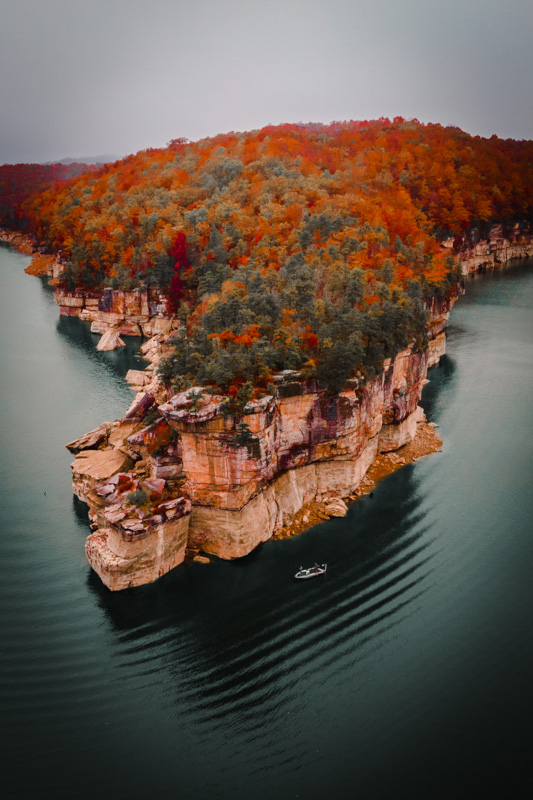
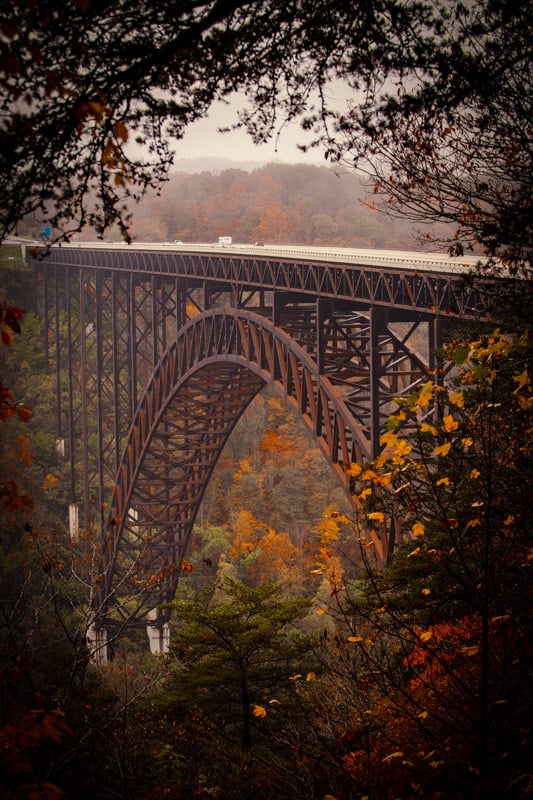
Southeast & Southern Appalachians (AR, GA, NC, TN)
I love chasing fall colors through the Southern Appalachians because the season stretches out longer than almost anywhere else. It usually starts at the highest ridges in western North Carolina and Tennessee in late September, where spots like Grandfather Mountain or Clingmans Dome explode early.
By mid to late October, the color slides down into Asheville, the Blue Ridge Parkway overlooks, and Georgia’s north mountain parks. Even into early November, the valleys and foothills of Tennessee and Arkansas are still glowing. The trick here is to use elevation to your advantage…start high, then drop lower each week. It means you can line up a series of weekends across AR, GA, NC, and TN and hit peak in each spot without missing a beat. This is the region where fall feels like it just keeps on going.
North Carolina mountains
The North Carolina mountains are my go-to for stretching out the season. I always start high: Mount Mitchell, Grandfather Mountain, and the ridges along the Blue Ridge Parkway often show color in late September and the first week of October. When those peaks are past, I’ll slide down to Asheville and the French Broad Valley mid to late October. By early November, you can still find good color in the foothills.
For planning, I follow the scientist-led App State “Fall Color Guy” blog…Dr. Neufeld breaks down the science and calls out what’s turning each week. I pair that with Explore Asheville’s Interactive Fall Color Map, which shows the elevation-based timing week by week, and the Asheville Fall Color Report for fresh photos and drive ideas. My strategy here is simple: start at the highest overlooks in early October, then step down in elevation each week until early November.
- Read also: My Favorite Places to Stay in Asheville
- You’ll also like: North Carolina’s Best Hidden Gems
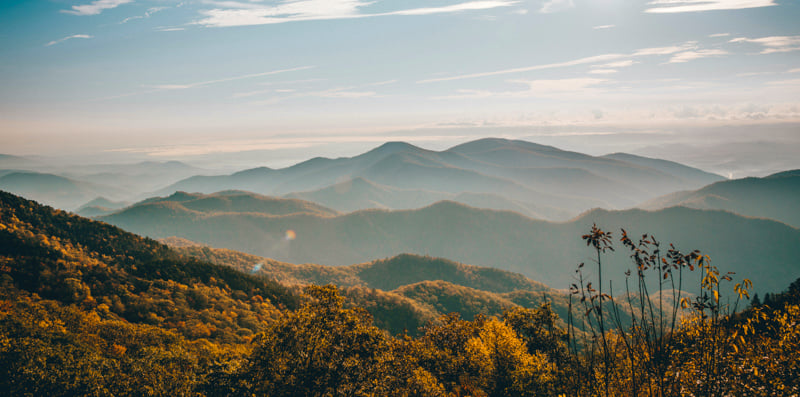
Great Smoky Mountains (TN/NC)
The Smokies are all about elevation. I plan at least two trips because the color here moves fast but at different levels. Above 4,000 feet — places like Clingmans Dome, Andrews Bald, and Newfound Gap — usually peak in late September into early October. Mid elevations (like Roaring Fork, Alum Cave, and the Appalachian Trail corridors) follow in mid October. By late October and early November, the valleys like Cades Cove and Oconaluftee are still glowing.
To time it right, I check the NPS Fall Colors page for guidance on elevation timing and suggested scenic drives. I also lean on Gatlinburg’s Fall Color Report, which posts weekly updates and webcams from the gateway town. My trick: pick one high-country hike early, then save a valley loop for Halloween week. That way, you get both ends of the spectrum.
- Read also: My Favorite Photo Spots in the Smoky Mountains
- You’ll also like: The Ultimate Gatlinburg Bucket List for Young People
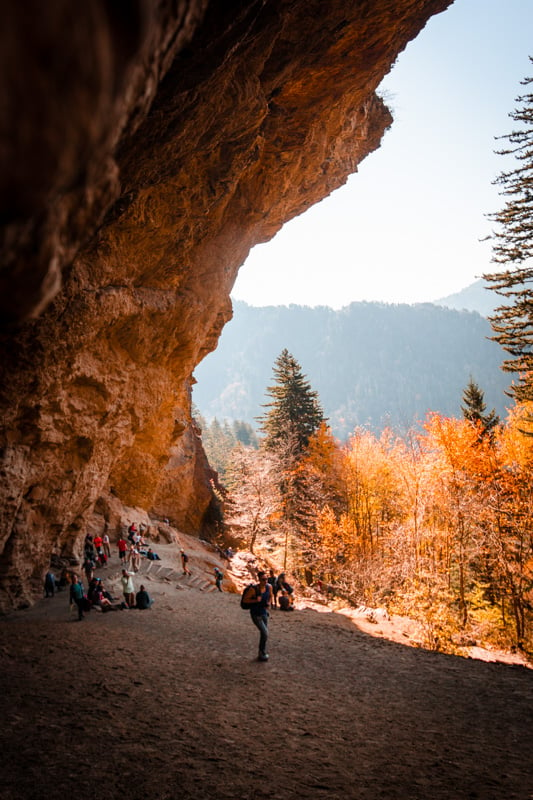
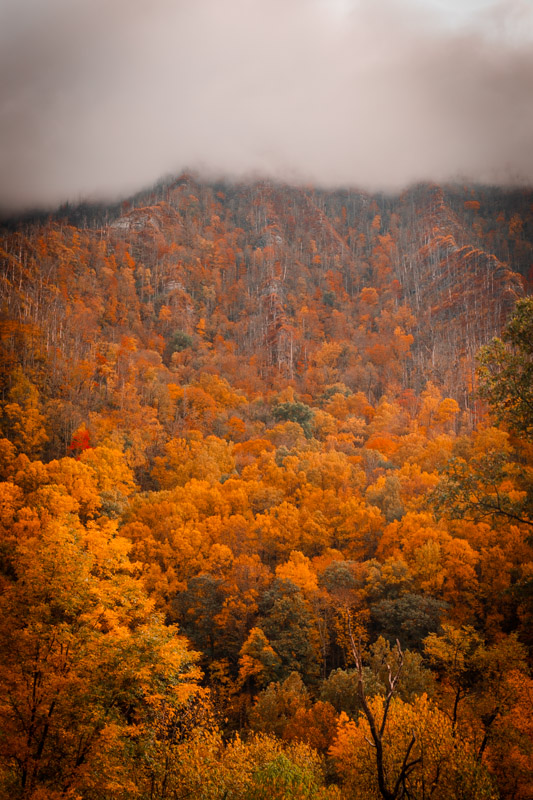
Georgia
North Georgia’s mountains might not be as tall as the Smokies, but the overlooks are spectacular. I love hitting Amicalola Falls State Park in mid-October, when the waterfall is framed by orange ridges. Black Rock Mountain offers sweeping views of three states, and Cloudland Canyon is stunning when the hardwoods around the rim start to glow. The Piedmont and foothills (think Chattahoochee National Forest and around Atlanta) often carry the season into early November.
The best planning tool is Leaf Watch by Georgia State Parks. Rangers post weekly maps, color percentages, and recommended trails from October into November. I time my hikes for the last two weeks of October in the mountains, then keep a backup plan for a foothills trip in early November if I miss peak. Here are some of my favorite hidden gems in GA that I recommend adding to your itinerary.
- Read next: Georgia’s Most Amazing Romantic Getaways
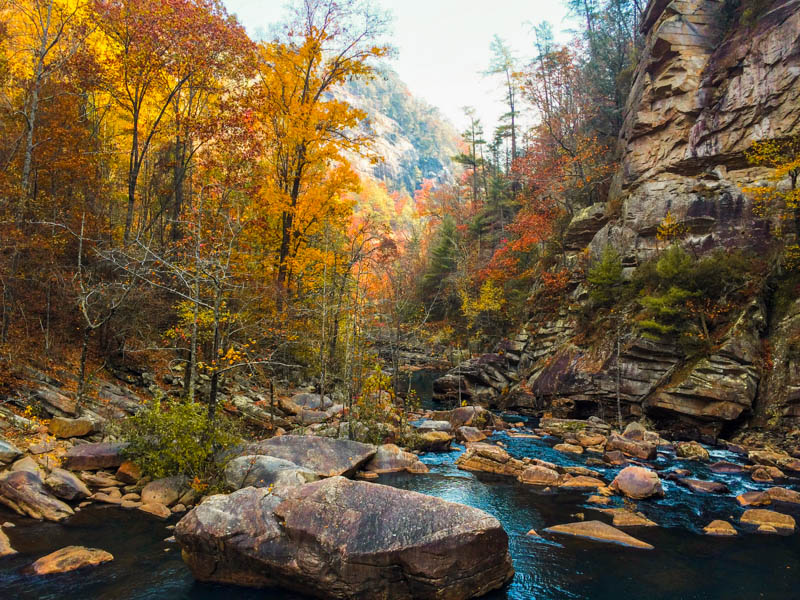
Arkansas
Arkansas has one of the South’s widest fall windows thanks to its range of elevations. The Ozark Mountains around Jasper and the Boston Mountains peak first, usually in the second half of October. The Ouachitas and central Arkansas follow in late October, and by early November the Delta and southern forests are still showing color. Some years, you can catch three separate peaks if you move around.
The state’s Fall Color Updates are my go-to. Each week, park staff post regional updates along with scenic byway suggestions…Scenic 7 Byway and Pig Trail Scenic Byway are classics. I also sign up for their fall foliage emails so I don’t miss a shift. My planning tip: lock a late-October Ozarks trip, then keep the Ouachitas or Hot Springs area in your back pocket for early November if you need a second chance.
- Read also: The Coolest Cabins You Can Rent in Arkansas
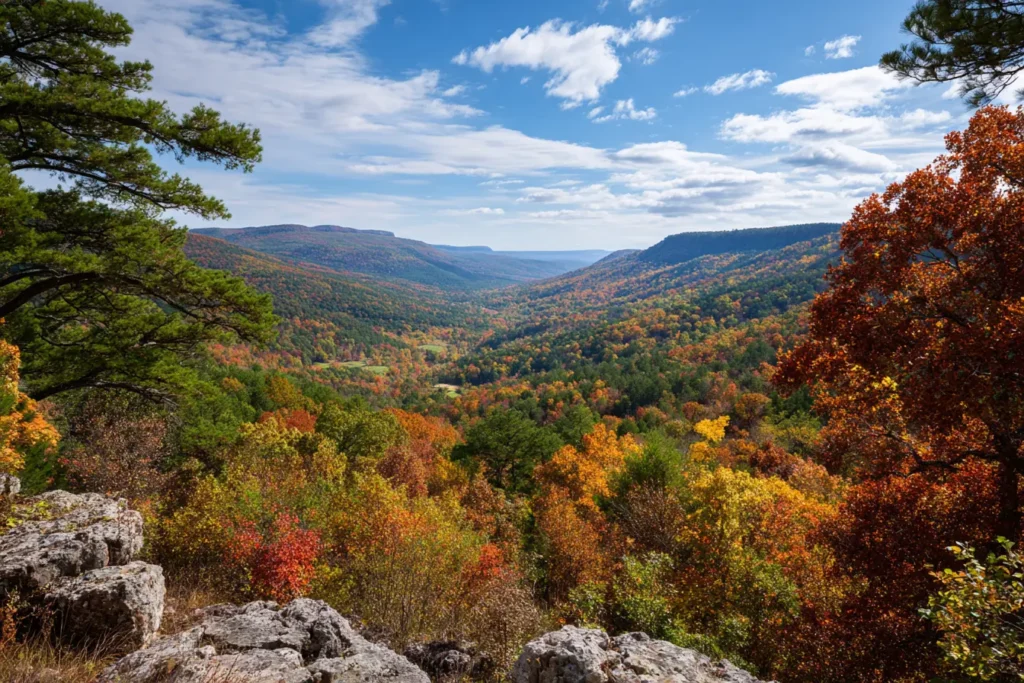
Midwest & Great Lakes (IL, MI, MN, MO, OH, WI)
When I chase fall colors on Midwest road trips, I think of it as a giant ripple moving south and toward the Great Lakes. Minnesota’s North Shore and the U.P. of Michigan often kick things off in late September, especially in higher elevations and near the Canadian border. By early to mid-October, the color spreads into Wisconsin’s Door County, northern Michigan’s Lower Peninsula, and Ohio’s forests.
A week or two later, you can still catch peak in Illinois’ river valleys and Missouri’s Ozarks. What I love about this region is the variety…lakefront drives with blazing maples, endless hardwood forests, and golden prairies all showing different stages at once. If you time it right, you can string together several weekends of peak color across six states, using the Great Lakes and latitude as your guide.
- Read my guide: The Cheapest Fall Foliage Destinations to Fly to Right Now
Minnesota
Minnesota has one of the best tools in the country for leaf-peeping: the DNR Fall Color Finder. It shows real-time color status at every state park, complete with photos uploaded that week. I usually target the North Shore of Lake Superior first in late September. Gooseberry Falls, Split Rock Lighthouse, and Lutsen Mountains are spectacular when the birches and maples peak.
By early October, the color wave moves south into the Twin Cities metro parks like Afton and Fort Snelling, and finally into the Mississippi River bluff country near Winona by mid-October. My tip: use the slider tool to preview typical peak windows, but always check the live map right before you go. Conditions can shift fast here, especially if the first frosts come early.
- Read next: My Favorite Minnesota Cabins in 2025
- You’ll also like: The Coolest Spots in Duluth, Minnesota

Wisconsin
Beautiful Wisconsin makes it easy because their tracker is so good. I like to start in the Northwoods or Cable/Hayward area in late September, then chase color south. Door County is a personal favorite…the mix of water views and backroads is peak mid-October. If I miss it there, I pivot west into the Driftless Area or Devil’s Lake State Park, where valleys often peak a little later. Here are some other cool hidden gems in Wisconsin I like to check out.
The Travel Wisconsin Fall Color Report is a crowdsourced map updated daily with hundreds of local reporters. You can filter by county and even use their embeddable widget to follow along. My strategy is to filter for Door County and surrounding counties when planning October road trips, then check the webcams they link for live confirmation. It’s one of the most detailed foliage trackers in the country…no guessing needed.
- Read next: The Coolest Lake House Rentals in Wisconsin
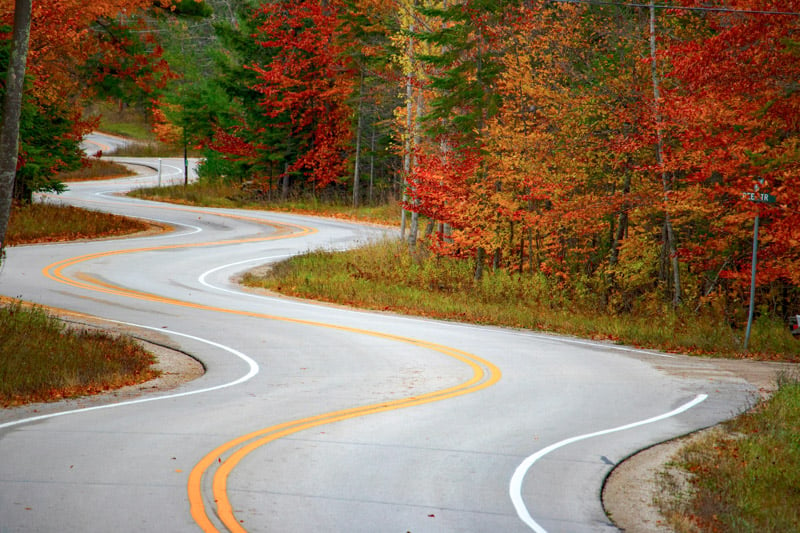
Michigan
Michigan’s fall is all about using the Great Lakes as buffers. I always start in the Upper Peninsula in late September…Pictured Rocks, Porcupine Mountains, and the Keweenaw usually pop first. By early October, Northern Lower Michigan (around Traverse City and Petoskey) hits its stride. Mid-October is prime for Lake Michigan shoreline drives like M-22, and even into late October the southern Lower Peninsula can still have good color.
I use the Pure Michigan Fall Color Map to preview timing across the state. If I’m Upper Peninsula-bound, I’ll double-check the UP Travel weekly reports, which break down conditions into west, central, and east every Wednesday. That level of detail is a lifesaver, since the U.P. is so big you can be hours off if you don’t plan carefully. My go-to tip: if a storm strips the U.P. early, you almost always get a second chance along the Lake Michigan shoreline a week or two later.
- Read next: My Favorite Picturesque Places in Michigan
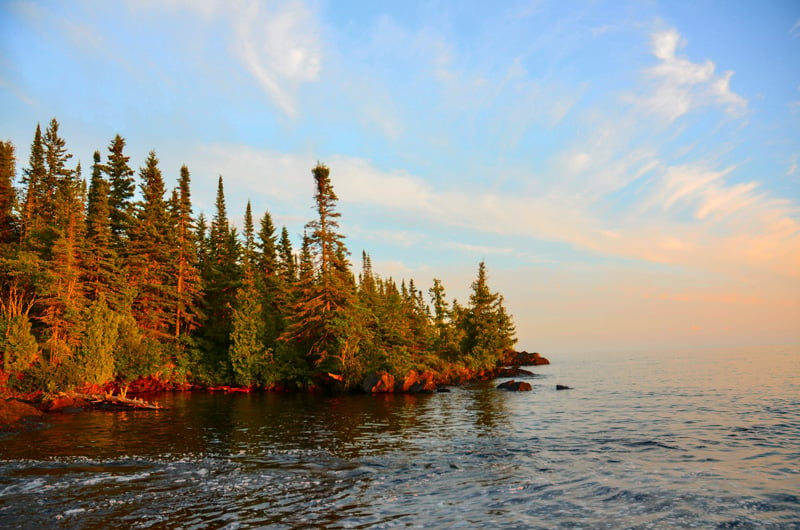
Ohio
Ohio has more variety than most people realize. In early October, I usually start up north in Cuyahoga Valley National Park or along Lake Erie’s shores. By mid-October, I move to Mohican State Park, where the gorge views are spectacular. Late October into early November is when Hocking Hills hits peak…waterfalls and deep ravines framed by maples and oaks make it a perfect finale.
The Ohio DNR Fall Color page is my planning anchor. They post a weekly progress map each Wednesday plus regional notes on what’s turning. My tip: don’t overlook their weekly “Fall Color Updates” video. It’s short but gives a quick sense of which parks are peaking that weekend. I also watch the north-to-south wave: if Cleveland is at peak, Hocking Hills is usually two weeks behind.
- Read also: 10 Amazing Spa Resorts in Ohio
- You may also like:
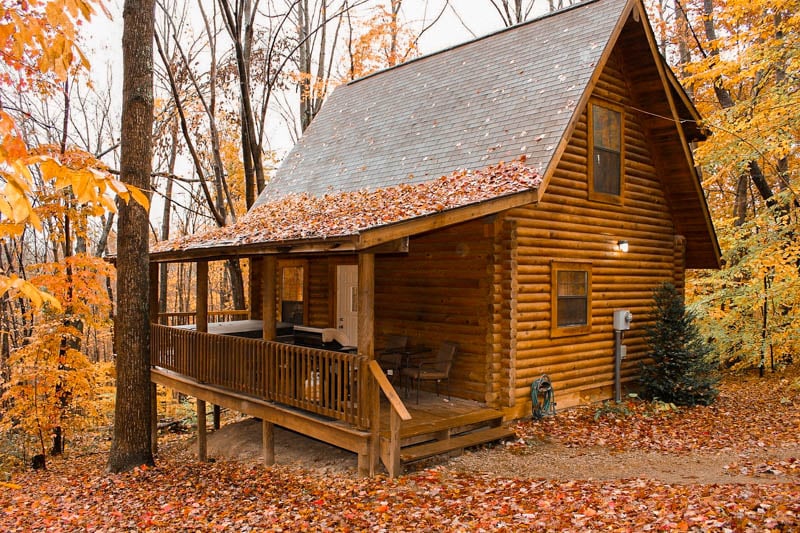
Illinois
The beauty of Illinois gives you a lot of choice depending on timing. Early to mid-October, I aim north to Galena for rolling hills and historic town backdrops. Mid-October is prime at Starved Rock State Park, with canyons framed in orange and red. By late October, I drive the Great River Road along the Mississippi, which is incredible when bluffs light up. For early November, Shawnee National Forest in southern Illinois still holds color when the north has dropped.
The Illinois Fall Colors Trip Planner is interactive and lets you scrub through predicted peaks across the state. It also pins ideas for drives and small towns, making it easy to match your dates to a destination. My advice: pick one anchor (Galena, Starved Rock, or Shawnee) based on your dates, then use the planner to add in secondary stops nearby.
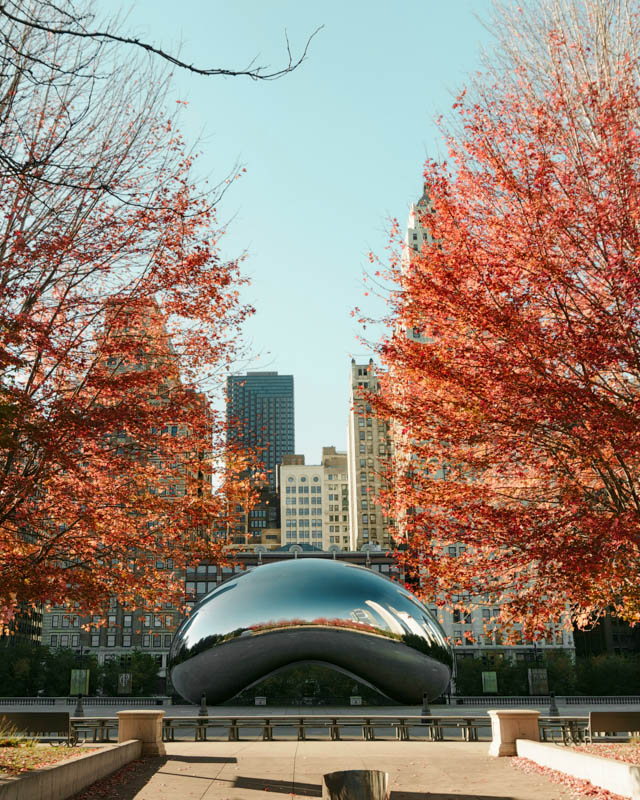
Missouri
Missouri is underrated for fall color. I like to start in northern Missouri around Mark Twain Lake in early October, then aim for the Ozarks mid-October when places like Ha Ha Tonka and Table Rock State Park hit peak. By late October, the color often lingers in the southern Ozarks and along the Current River. The north-to-south progression means you can adjust depending on whether the season is early or late.
The Missouri Department of Conservation’s Fall Color page posts regional updates weekly from mid-September through early November. They also break it down into eight regions with simple status notes (e.g., “Maples are near peak in the Ozarks”). My planning tip: use their Thursday updates to plan a weekend loop…if central Missouri is past peak, head south. The staggered progression makes it easy to salvage a trip even if weather strips the leaves in one area.
- Read also: Missouri’s Most Beautiful Spots to Visit
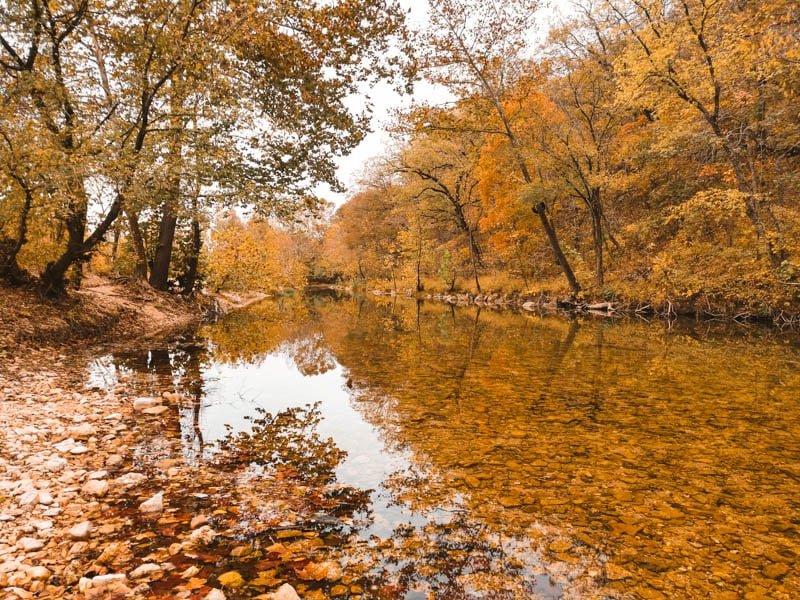
Rockies & Southwest (AZ, CO, NM, UT)
The Rockies and Southwest deliver some of the most dramatic fall color I’ve ever seen with towering golden aspens framed by snowy peaks and red rock canyons. The season here is short but intense. Colorado’s high passes and ski towns often peak first, usually late September into early October, with places like the San Juans, Aspen, and Crested Butte stealing the show.
Around the same time, northern New Mexico’s high country lights up, followed by Santa Fe and the cottonwoods along the Rio Grande later in October. In Arizona, the San Francisco Peaks and Flagstaff blaze in early October before the color drops into Sedona’s canyons. And in southern Utah, Cedar Breaks and the Markagunt Plateau peak in late September, with color lasting longer in the lower valleys. Out here, elevation rules everything…you’ve got to be ready to move quick.
Colorado Rockies
Colorado’s fall color window is short but spectacular. I usually start in Colorado’s San Juan Mountains…drives like the Million Dollar Highway between Ouray and Silverton, or the Dallas Divide near Ridgway, often peak in late September. Around the same time, the Kebler Pass corridor near Crested Butte becomes a tunnel of yellow aspens, and Independence Pass outside Aspen lights up. By early October, the lower basins and Front Range foothills hold the last of the season.
The challenge is timing…a single windstorm can strip the aspens. That’s why I check the Explore Fall Colorado Fall Foliage Map daily once September hits. It blends predictive modeling with crowd reports, so I can see if a pass is already past peak before committing to the drive. My trick: book lodging with flexibility, then chase whichever corridor is flagged as “go now” on the map.
- Read also: These Are the Top Places I Recommend Staying in Colorado
- You’ll also like: My Favorite Beautiful Destinations in Colorado
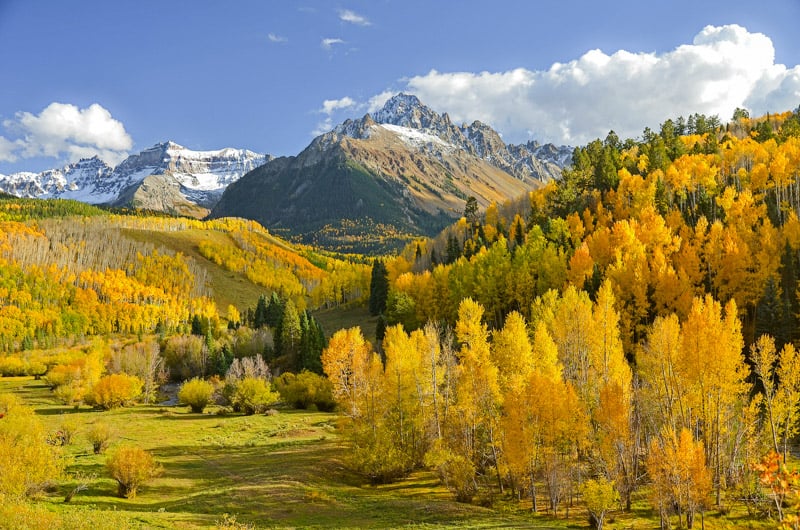
Arizona High Country
Northern Arizona has one of the most photogenic fall displays I’ve seen, thanks to golden aspens framed by red rock. Flagstaff’s San Francisco Peaks usually pop in the first half of October, with prime color around the Inner Basin Trail and Arizona Snowbowl. By mid-October, I’ll drop into Oak Creek Canyon and Sedona, where the sycamores and maples turn later and give you a second chance at peak.
I always check the Flagstaff LEAF-ometer before heading out. It’s a simple dial updated multiple times a week, plus notes on which specific zones (Peaks, canyon, or town) are at their best. If the Peaks needle is already past, I know to head to Sedona instead for red rock plus color.
- Read also: The Top Experiences in Arizona for Young Adults
- You’ll also like: My Ultimate Arizona Road Trip Guide
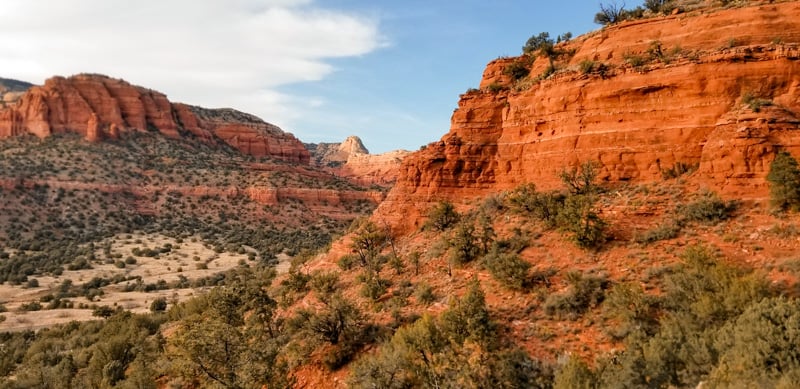
New Mexico
New Mexico offers a long, staggered season. Late September to early October is when the Enchanted Circle around Taos and Aspen Vista outside Santa Fe usually peak. The hikes up into the Sangre de Cristos are unreal when the aspens are glowing gold. By mid to late October, I pivot to the cottonwood bosque along the Rio Grande in Albuquerque, which lights up with yellows. Southern New Mexico, like the Sacramento Mountains, can hold color into early November.
The New Mexico True Fall Colors guide is my planning hub. It’s not live-tracked, but it lays out the key byways and timing by region. I use it to set my trip window, then cross-check with local tourism boards or social media for real-time confirmation. My tip: plan two stages…one trip north for aspens, another south for cottonwoods, if you want to see the full spectrum.
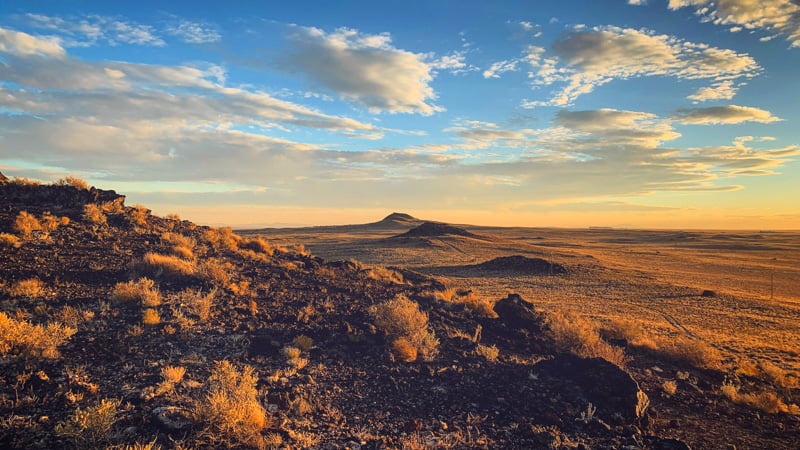
Southwest Utah high country
Southern Utah delivers one of the most striking contrasts of fall anywhere: glowing yellow aspens against red rock cliffs. Cedar Breaks National Monument and the Markagunt Plateau usually peak in late September into early October. I like to drive Highway 143 from Panguitch to Brian Head or detour along Cedar Canyon for incredible views. By mid-October, color lingers in lower canyons around Cedar City.
For updates, I check the Cedar Breaks NPS Fall Colors page, then follow the Visit Cedar City Fall Color Report, which posts bi-weekly photos and current status across elevation zones. This combo lets me know whether to aim high for Brian Head or stick to lower valleys. My advice: get there early…Utah’s high country color burns bright but fades quickly. Here’s my Utah National Park road trip itinerary that I suggest following anytime of year, especially the fall!
- Read also: The Prettiest Bucket List Spots in Utah
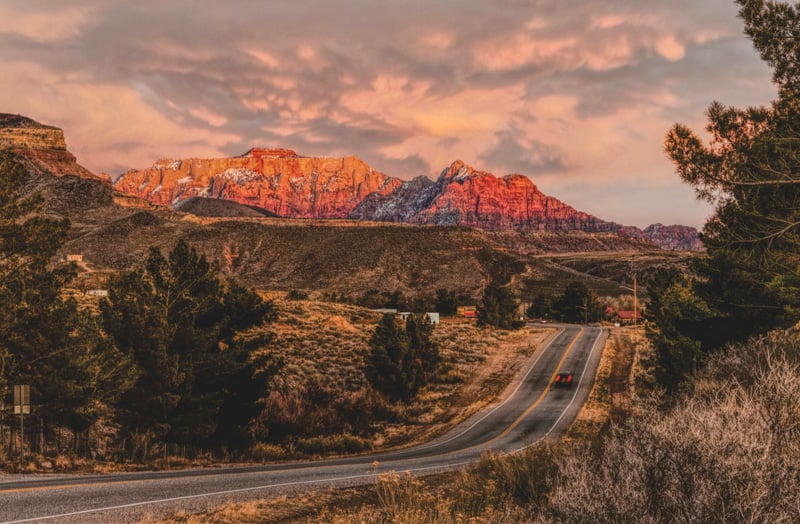
California & the Sierra Nevada (CA)
California’s fall season is sneaky good, and it’s all about chasing aspens along the Eastern Sierra. I usually start with the Bishop Creek Canyon outside of Bishop…the South Lake and North Lake areas often pop in the last week of September. A week later, the show spreads to Rock Creek and Lundy Canyon, then into the June Lake Loop and Mammoth Lakes Basin by early October.
By mid-October, Conway Summit and Mono Lake overlooks are usually at their peak, and you still have the Owens Valley holding color when the higher basins are bare. As the weeks go on, the lower valleys and foothills carry the torch into late October, while Northern California wine country and coastal spots keep the season alive into November.
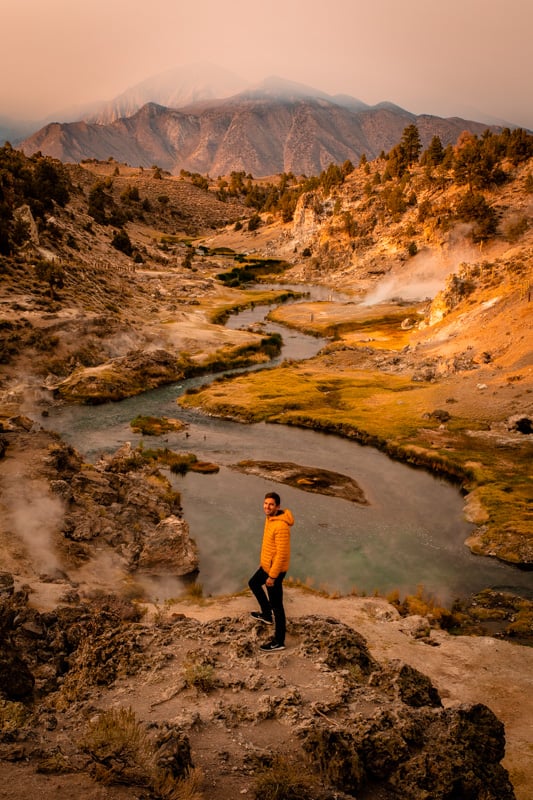
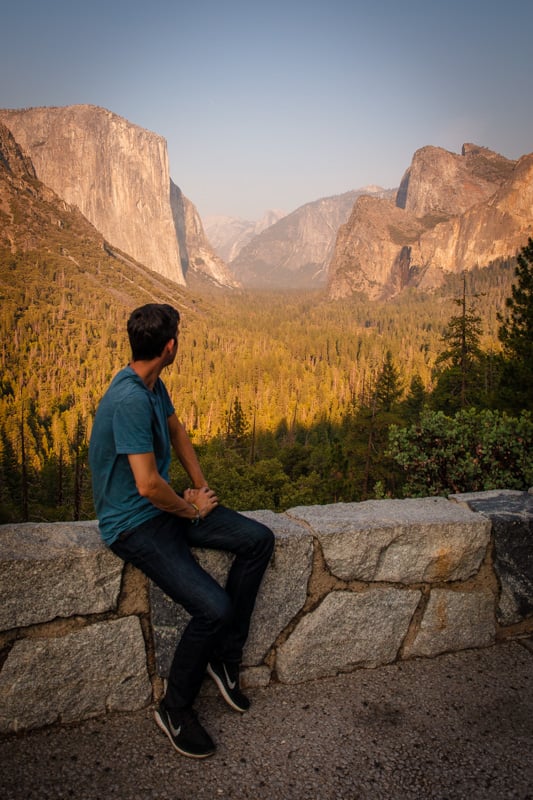
What makes it tricky is how elevation stacks the timing. 10,000-foot trailheads can peak and drop within a week, while valleys down near 6,000 feet lag by two to three weeks. That’s why I always cross-check multiple sources: CaliforniaFallColor.com posts near-daily updates with photos from spotters statewide, the county tourism board runs its own Mono County Fall Colors Report, and Visit Mammoth publishes seasonal guides for local lakes and hikes.
My Pro Tip: plan a Highway 395 road trip with flexibility. If Bishop Creek has already peaked, June Lake or Convict Lake might still be glowing. And if you miss the high-country aspens, you can push west…Yosemite Valley and Sequoia Groves often hold color into late October and early November. California’s beauty is that you get multiple shots at peak if you’re willing to move between elevations.
- Read also: My Ultimate Northern California Bucket List
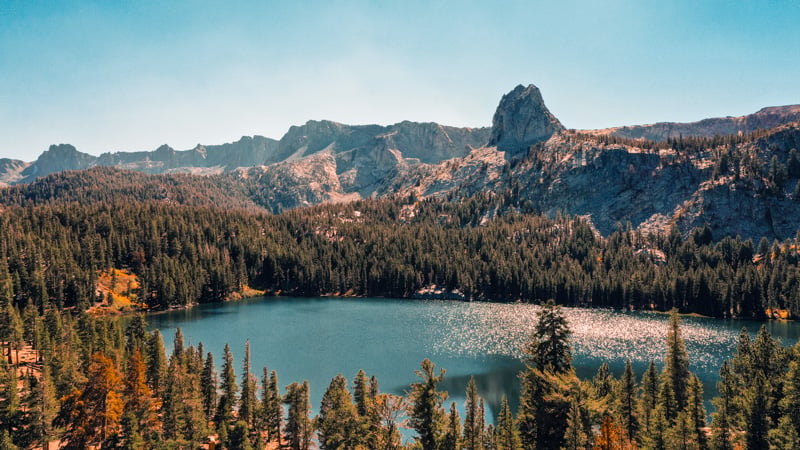
Pacific Northwest (OR, WA)
Fall in the Pacific Northwest feels different from anywhere else I’ve leaf-peeped. Instead of endless hardwood forests, you get a mix of vine maples glowing red under the evergreens, golden aspens in mountain meadows, and fiery bigleaf maples lining rivers and waterfalls. In Washington, I like to time the North Cascades and larch hikes in early to mid-October, then shift west toward the Puget Sound lowlands as the month winds down.
Oregon usually peaks mid- to late October. The Columbia River Gorge, Willamette Valley wine country, and Southern Oregon parks all put on stunning shows, with Portland’s Japanese Garden as a reliable indicator of the city’s timing. The trick here is flexibility: mountain color is short and weather-dependent, but if you miss it, the valleys and cities keep the season alive well into November.
- Read also: My 30-Day PNW Road Trip Itinerary
Oregon
I start with Central Oregon and the Cascades in early to mid-October. Hikes near Bend or the McKenzie River Trail pop early thanks to cooler nights. Then I pivot west into the Willamette Valley vineyards (amazing golds and reds among the vines) and Columbia River Gorge waterfalls around mid-October. Portland itself, especially the Japanese Garden, usually peaks late October into early November.
The best planning resource is Travel Oregon’s Fall Foliage Guide, which outlines peak windows by region and top scenic drives. For a hyper-local check, the Portland Japanese Garden Fall Color Tracker updates daily in season, which is my go-to to know if the city is ready. My advice: time one Gorge hike mid-October, then hit Portland at the tail end of the month.
- Read also: The Prettiest Places to Visit in Oregon
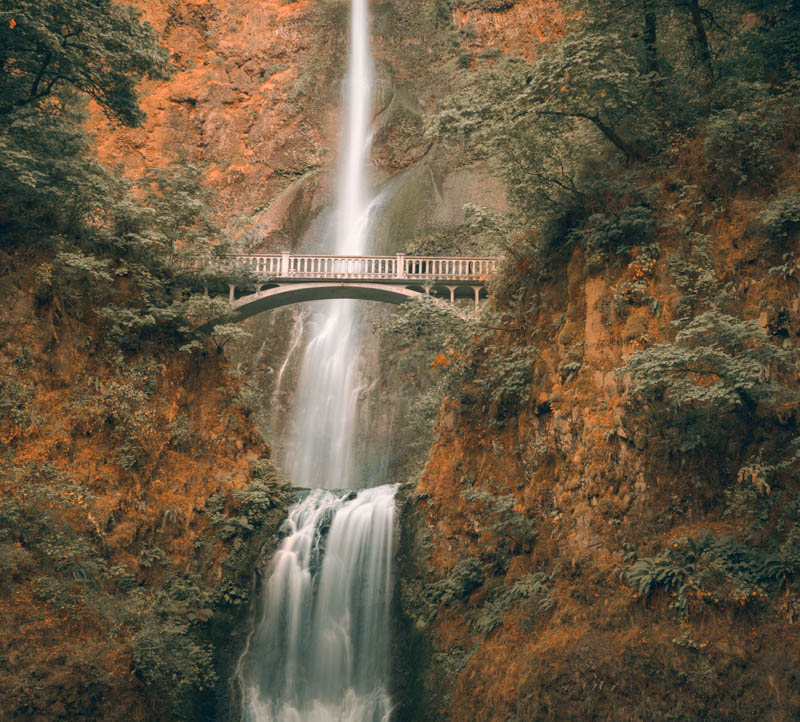
Washington
Visiting Washington is all about timing the larches. In late September to early October, I target the North Cascades. Hikes like Maple Pass Loop or Heather-Maple Pass are breathtaking when the alpine larch turn gold. By mid-October, I’ll drop into the Central Cascades near Leavenworth or Mount Rainier for vine maples and mountain ash. I recommend staying in one of these spa resorts to see the action up close! The Puget Sound lowlands and Seattle’s arboretums usually carry color into late October and early November.
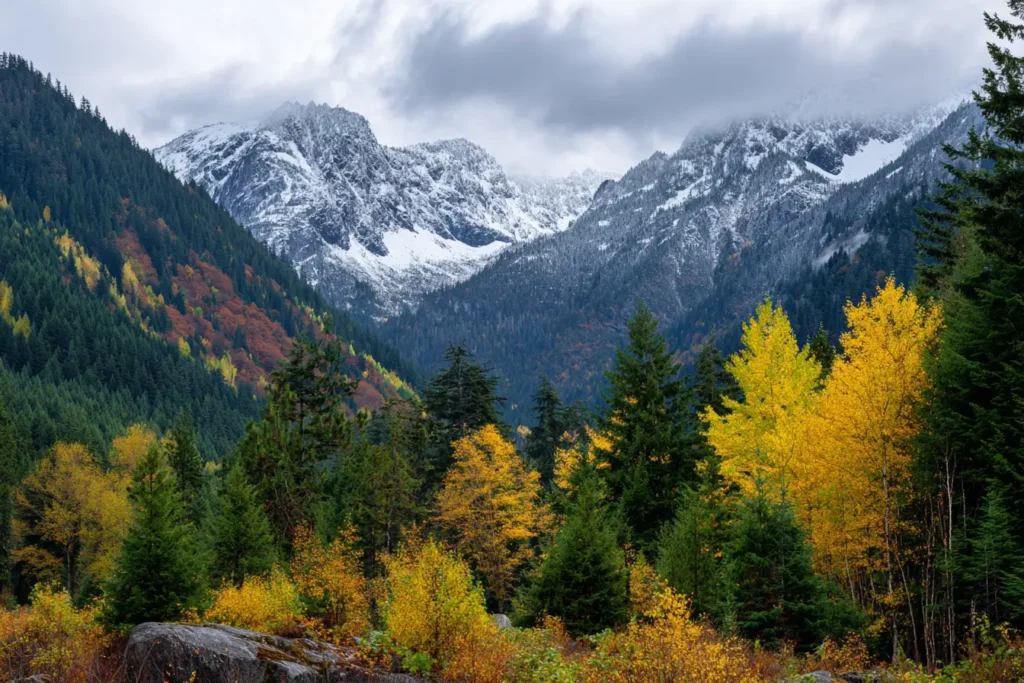
To plan, I use the Explore Fall Washington Map, which gives daily forecasts and crowd-verified reports statewide. For trails, I also check the Washington Trails Association trip reports…hikers often mention fall color in real time. My trick: aim early for high-elevation larch hikes (they can drop in a week), then keep a backup weekend in Seattle or the Skagit Valley for late-season maples.
- Read next: The Most Unique Places to Stay in Washington
